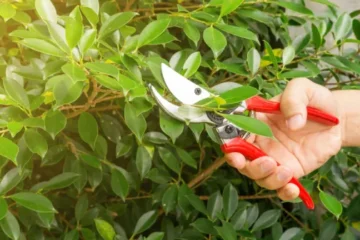Why are bonsai Tree leaves falling off and you don’t know what to do. We will explain everything to you. Except for deciduous species, when a bonsai tree leaves falling , it is bad. He surely suffers from a physiological disorder due to poor maintenance . An unsuitable location, a lack of light, a parasite can be the reasons for the loss of foliage. One must observe the bonsai tree as a whole in order to identify the symptoms.
Know how to observe your bonsai tree
Content Overview
To understand why your bonsai tree leaves falling off , you must observe the symptoms and identify the reasons for its discomfort. Above all, do not have the reflex to water it, give it fertilizer or treatment. Before treating your bonsai tree, you must find the factor or the reason for this bonsai tree leaves falling off.
Why Are Bonsai Tree Leaves Falling Off?
There are many reasons for bonsai tree leaves falling off. Among these, the most common cause of bonsai tree leaves falling off is lack of proper care. If you don’t cut dead branches, they will continue to grow and eventually form new ones. It can be a tangled mess of branches and leaves. Below are the few reasons Why are bonsai tree leaves falling off.
1.Lack of adequate Sunlight
If your indoor bonsai doesn’t get enough sunlight, this is the main cause of bonsai tree leaves falling off. Naturally, these are sun-loving plants. Normal indoor lighting for humans is not sufficient for most species to grow.
Although insufficient light will not kill the plant right away, it will slow the growth process which can cause the bonsai tree leaves falling off. Finally, if you pruning the tree, its leaves and branches will not grow back.
Indoors, place the plant on a south -facing windows to get maximum sunlight, as they need plenty of it to thrive.
At the same time, many outdoor species of bonsai cannot withstand extreme temperatures and their nodes and internodes can be very large. Consequently, these species may also shed leaves. Moreover, they are more susceptible to disease and pest attacks.
Read More :Why Ficus Tree Losing Leaves?
2.The change of location
A bonsai can be stressed by the sudden change in its environment and this stress causes bonsai tree leaves falling off. The bonsai is sedentary and does not like sudden changes in temperature or light. If the bonsai has been recently acquired or has moved, it is most likely due to its change of location .
This transient stress is noticeable when bonsai tree leaves falling off, but you see young buds . If it is placed in a bright place, your bonsai should make new leaves after one to two weeks. Time for him to acclimatize to his new environment.
Points to check
- Choose a sunny location on your patio or a bright spot near a window if grown indoors.
- Keep it away from drafts , strong winds and heat sources like the radiator. If you air your room in the winter, move it around for a few minutes.
- Keep your bonsai in an environment where the temperature is appropriate for its species .
You have just purchased your bonsai
If you’ve recently purchased your bonsai, it may be under stress from the change in environment . This results in the fall or partial bonsai tree leaves falling off.
Stop all fertilization and just water your bonsai properly and place it in an environment with light suitable for its species. After a few weeks, your bonsai should produce buds and new leaves very quickly.
3.Improper Drainage
Being miniature trees, bonsai are grown in small containers. Both indoor and outdoor bonsai require specific care compared to other potted plants.Trees grown in small containers have limited space for nutrients and water.
When watering bonsai, if you notice that the water drains too quickly or doesn’t drain at all, it may be due to “rootbound”. This is a condition where the root system is disrupted. As a result, the roots will not absorb water and nutrients properly.
These plants are more susceptible to drying bonsai out quickly or may retain excess moisture due to over-watering. This is why these plants are more prone to show signs of problems such as yellowing of leaves and out-of-season bonsai tree leaves falling off.
4.Over-watering of bonsai plants
Over-watering your bonsai can cause root rot. This happens if you water your bonsai multiple times every 2-4 days depending on where you live and what kind of bonsai tree you have.
Over-watering will cause the roots to rot, causing your bonsai to lose its leaves. Root rot bacteria enter the roots through excess moisture.
Another factor that can cause over-watering is poor soil conditions. You need well-drained bonsai soil, so that excess water can drain out and the roots can breathe.
Best quality bonsai soil allows bonsai roots to easily absorb nutrients from the soil.
5.Bonsai tree under-watering
Bonsai needs more water than most plants. Their roots grow in the ground, but their leaves remain above ground. Bonsai are usually kept indoors because they are too hot or too cold. They need to be watered regularly.
More frequent watering is required during the growing season during the spring and summer months. Plants need more water when the temperature rises.
Containers with high humidity should be placed. To avoid drying out, water bonsai plants regularly whenever you notice the soil is drying out.
6.Overfeeding or underfeeding bonsai plants
Plant food is essential for the healthy growth of bonsai plants. You should use both liquid and solid fertilizers depending on the needs of the bonsai plant species you have.
If there is an absence of nutrients in the soil, the leaves will turn yellow-brown and the shoots will not grow properly. Less feeding causes the bonsai tree leaves falling off. Eventually, your bonsai tree will be unable to fight disease.
Osmosis usually occurs in plants where water moves from the roots to the leaves. If you feed your plant too much, plasmolysis occurs, where fluids begin to flow in the opposite direction instead of through the cell walls. Plasmolysis (breakdown of chlorophyll) causes the bonsai tree leaves falling off and to become the tree leaves dull
Bonsai needs feeding about every month during the growing season. They require fertilizers containing nitrogen, phosphorus, potassium (NPK respectively). Organic fertilizers contain more nutrients than chemical fertilizers. It is important to switch to low-nitrogen feed during cultivation.
7.Pests and Diseases
If your bonsai tree leaves falling off continuously after following proper care tips, it could be due to pests or disease. The most common diseases include root rot, rust, black spot, fungal infections such as damping off, gall, powdery mildew and others.
Insects are also a cause of bonsai tree leaves falling off. The most common pests that damage these plants are scale insects, spider mites, aphids, vine weevils, root aphids, and adelgids.
8.Recent Bonsai Repotting
After repotting, the bonsai lost some leaves due to the stress of moving to a new home. But if the new soil is of good quality, the leaves will grow again. Follow these simple care tips after repotting to help reduce stress.
Repotting is best for most bonsai tree species choices at the beginning of the growing season in early spring when the weather starts to warm. They prefer a temperature range between 55° and 65° Fahrenheit.
After repotting, keep the soil slightly moist until the roots establish themselves. Watering too early will kill the new roots. Wait at least two weeks before watering. After that, water once a week until the soil is completely dry.
For fertilizers, wait 3-4 weeks before feeding. This gives the bonsai enough time to establish itself in its new environment.
What are the signs of bonsai tree leaves falling off?
There are numerous Symptoms about the bonsai tree leaves falling off.These the are following-
Bonsai tree leaves falling off in winter
Did your bonsai tree leaves falling off in winter? If yes, just don’t panic and keep reading.Bonsai trees drop their leaves to retain as much water as they can while dormant. Winter is the main cause of bonsai tree leaves falling off.
Generally, all species of trees are dormant during winter. As day length decreases, deciduous trees begin to drop their leaves and go dormancy.
This is part of the natural life cycle, and plants respond to changes in day length. If you bring your dormant plant inside for winter protection, you are messing with nature and your plant will eventually die.
However, if the temperature remains below zero degrees for more than 48 hours, it is called overwintering.
In this case, you should move the plants to a green house or drop so that the temperature rises only a few degrees. You can use a horticultural frost cloth like this one which will provide frost protection.
Again, avoid planting your dormant plants in a hot room. Furthermore, bonsai require less water when dormant in freezing temperatures.
Bonsai tree leaves falling off in summer
When it gets too hot outside, bonsai plants can struggle with the heat. Their leaves may dry up and fall off. In fact, they may even begin to dry out.
This makes the leaves feel heavy and dries them out. You can protect this by watering your bonsai trees regularly.
Strong direct sunlight can cause leaves to turn yellow and become brittle. To avoid this, you should move the bonsai to a shaded area. It will still get bright indirect light, but not the harshness of direct light.
Overfeeding your bonsai can cause the bonsai tree leaves falling off and turn yellow Always use a small amount of fertilizer when feeding your bonsai. Too much fertilizer can cause the bonsai tree leaves turn brown.
Bonsai leaves turn yellow and fall off
It is important to know what is causing your bonsai tree leaves falling off and to start turning yellow. Many factors can contribute to your bonsai turning yellow and falling.
One reason is excess sun exposure. Your bonsai tree needs a lot of shade to thrive green and healthy. On the other hand, lack of sunlight can also cause the bonsai tree leaves falling off and turn yellow.
Over-watering and under-watering bonsai will turn yellow and bonsai tree leaves falling off. Proper bonsai watering is to water when you see the top 1-2 inches of soil dry out. You can use your finger to test by sticking your finger in the soil.
Pests and diseases can cause your bonsai to turn yellow and lose its leaves. If you notice anything unusual like mold or insects in your bonsai, you can use insecticidal soap or neem oil to treat it.
Another common problem with yellow leaves is a lack of nutrients or, conversely, over-fertilization. Improper fertilization leads to nutritional imbalances. This can result in poor root development, stunted growth and leaf discoloration.
Bonsai leaves turn brown and fall off
The most common causes of bonsai tree leaves falling off and brown are overheating and over-watering. The leaves will look dry and withered.
You can try spraying some water directly on the leaves to revive them. Alternatively, you can miss your bonsai every day. Be sure to mist only the top of the plant and do not add more water if the bonsai is already watered.
Overexposure to the sun can cause bonsai tree leaves to turn brown and fall off. You can see symptoms of leaf blight, when the leaves turn brown and curl at the edges.
Some tips to prevent this are to keep your bonsai in a shady spot during the day. If you have no choice but to leave it in full sun, cover it with a large umbrella or tent.
Also, make sure your bonsai has enough water. Watering your bonsai every few days will help keep it hydrated and prevent it from drying out.
Overfeeding will also cause brown leaves and fallen leaves. Try to use a fertilizer that contains less nitrogen than potting Soil mix. This will prevent your bonsai from getting too many nutrients.
Root rot and other root damage can also cause bonsai leaves to turn brown and lose leaves. Make sure you check your bonsai regularly and remove any dead or damaged roots when you see any brown leaves falling off.
Read More : Why Black Spots on Bonsai Leaves?
How to fix the bonsai tree leaves falling off?
Hopefully, you are now fully aware of the reasons responsible for bonsai tree leaves falling off on your masterpiece of art – Bonsai. Here are some ways to bring your miniature bonsai tree leaves falling off back to life. Let’s discuss those ways below.
1. Watering your bonsai tree properly
When it comes to watering bonsai plants, there are no hard and fast rules. All you need to do is avoid watering during daylight hours.
If you notice that the top soil is drying out, use a spray bottle to water it. Make sure you let the soil dry out between watering and water again only when the soil is dry.
Also, you can water by soaking the leaves. This will help the plant absorb moisture from its leaves and wash away pests.
Akdama commonly used for bonsai is reddish when dry, but dark brown when wet. This change in soil color will remind you when to water your bonsai tree.
2.Improved sunlight exposure
Bonsai plants need good sunlight to grow properly. You can improve the amount of sunlight by placing them near a window or using artificial lighting.
How much light depends on the light requirements of the plant species you choose. Bonsai pots placed on windowsills can provide plenty of light. If you have one available, change the bonsai location to a south-facing window.
If you don’t have many windows, getting grow lights will help increase the amount of light available to the bonsai.
3.Improve soil quality

If the water drains too quickly through the container, it means the soil is not absorbing the water. This can be due to root rot or poor soil quality. In this case, you need to replace and prune the damaged roots of your bonsai.
Depending on the species, different soil mixes can be prepared for your bonsai. But commonly used are aqdama, lava rock, pumice, some river sand and charcoal. The best option is how to make your own bonsai soil mix using different ingredients like this pumice.
4.Keep Balanced fertilization
Promote respiration in your bonsai in a balanced way, so that fluids and nutrients move from the roots to the plant. A balanced fertilizer is best for most bonsai species.
If you over-fertilize your plant, the salt content in the soil will increase, which will encourage plasmolysis and eventually leaf drop.
Generally you can use both liquid and solid fertilizers. Liquid fertilizer should be mixed twice a month during the growth of young plants. Solid fertilizer should be applied twice a year.
Both organic and synthetic fertilizers can be used. Synthetic fertilizers can be absorbed directly by bonsai without the need for microorganisms. You can also control how much you feed.
However, it will mostly be washed away with subsequent water. Try to avoid artificial fertilizers as they can kill beneficial soil bacteria and mycorrhizal fungi.
Organic fertilizers work by slow release. Overfeeding with organic fertilizers is much more difficult than with synthetic fertilizers. But also, it is difficult to control how much it is released.
But always remember to follow the instructions on the package. Throughout the growing season, you can fertilize about 1-2 times a month. Please use an organic feed with a balanced ratio of such ingredients and beneficial microorganisms.
Avoid any food during winter.
5.Disease and pest control

Diseases can cause leaf drop. These include bacterial wilt, powdery mildew, black spot, leaf blight and other diseases. Some pests such as aphids also cause leaf drop.
Here are common diseases and pests you’ll want to look out for and ways to treat and prevent them.
Leaf spot disease causes small brown spots on the leaves. The disease can be treated by removing infected leaves and using a solution to treat them.
Powdery mildew is a disease that causes leaves to turn yellow or brown. It is caused by mold growing on plants. You should apply an anti-mildew agent to prevent this problem.
Sooty mold is caused by insects that feed on plants. Insecticide treatments are used to control rust and black spot diseases.
Root rot is caused by poor drainage and when the roots are root bound. Roots look tangled and messy. This prevents proper drainage.
Rust and black spot is Leaves turn yellow due to rust and black spots. Root care and proper drainage prevent these problems.
Aphids feed on plant liquid and cause slow growth. In case of infestation, you can knock them out by using a brush and applying insecticidal soap.
Spider mites will create webs of white grass between the branches. Get rid of spider mites by using an insecticide like malathion.
Scale insects are usually found on the bark and stems of plants. They suck the liquid from the tree. Use an insecticide to remove scale insects.
Fungicides are used to treat fungal infections. Pesticides are used to control pests and insects.
Follow these simple tips for indoor and outdoor bonsai plants.
Indoor Bonsai Trees Care Tips

Indoor bonsai plants should be watered regularly and given adequate sunlight. They also need suitable soil conditions. When they are sick or injured, they should be moved away from other plants to prevent the spread of disease.
Bonsai trees are popular among people who want to plant indoors trees.
Outdoor Bonsai Trees Caring Tips
Deciduous trees lose their foliage as part of the natural cycle of life. Evergreen trees do not falling off their leaves. These plants are usually found in cold climates.
You should choose the right type of bonsai according to the climate of your region. For example, if you live in a cold region, you should select species that can withstand freezing temperatures. If you live in a warm region, you should choose plants that can survive hot summers.
After identifying the main causes of bonsai tree leaves falling off, you can easily decide whether your bonsai tree is suitable for indoors or outdoors.
Will your bonsai grow back leaves?
This is one of the most important questions of bonsai art lovers. Let’s answer it briefly. It totally depends on the extent of damage to the bonsai tree.
If your plant is still alive, the leaves will grow quickly with proper care. However, if your plant’s roots completely dry out, the chances of regrowth are minimal.
The key to successful recovery of your bonsai depends on early intervention of leaf drop. Be sure to water your plant moderately for a few weeks and keep it in a sunny spot indoors.
In case of illness, recovery is difficult if you do not seek proper treatment. In summary, mild to moderate bonsai tree leaves falling off problems can be resolved with proper care.
Read More :The Ultimate Guides How To Revive a Bonsai tree
Conclusion
Hopefully, you have learned a lot about bonsai tree leaves falling off problems in your miniature art plants. Most importantly, select bonsai species that can thrive in your climate.
Don’t forget to take care of your plants. Do not leave them unattended. When you are away from your home for long periods of time, arrange for them to be watered in your absence. Undoubtedly, it gives a deep sense of satisfaction whenever you see your hobby blooming with glory.



